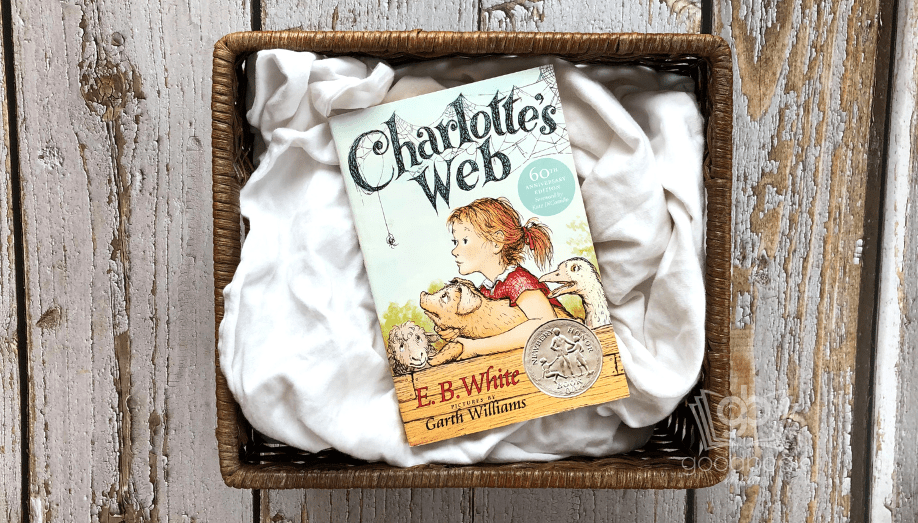
Summary
Charlotte’s Web is a story of a pig named Wilbur, who, like most pigs on a farm, is raised for the sole purpose of one-day becoming food for humans. Wilbur meets his first encounter with death shortly after birth, when being born a runt, his owner, Mr. Arable, seeks to eliminate the hassle of having a runt through extermination. Mr. Arable’s daughter, Fern, pleads with her father to not kill Wilbur, but instead allow her to raise the pig. After much debate, Mr. Arable agrees, and Wilbur is lovingly cared for by Fern for the first few months of his life.
When Wilbur grows too big to be kept with the Arable family, he is sold to the Zuckermans. He is given a place in the barn with the other animals, one of which is a spider named Charlotte. It isn’t long on the farm before Wilbur learns of Mr. Zuckerman’s plan of butchery for him. Distraught and depressed, Wilbur cries out to his new friends for help, and it is eventually Charlotte who takes an interest in saving Wilbur. After much consideration, Charlotte spins her web to state: “Some Pig” and this stuns the Zuckermans. Word spreads of Wilbur and people come from all around to see the pig who has words displayed above his stall in the barn.
Wilbur is brought to the fair where Charlotte spins her last web for him. The word “Humble” is enough to win Wilbur the prize at the fair. As an award-winning pig, Wilbur gains much popularity and his fate of being butchered is permanently removed. Charlotte breathes her last at the fair after leaving a sack of eggs. Wilbur takes the eggs back to the farm with him and builds relationships with Charlotte’s offspring. Having been saved from his many trials, Wilbur spends the rest of his days enjoying life, remembering Charlotte, and being grateful for her web.
Reading Level: 8-12 years old
Read Aloud Age: 5+
Mom Thoughts
This classic tale is surely enjoyable for all ages. Not only does the book include many fun illustrations, but it also carries readers through various plot points of interest. This book allows for parents to discuss themes with their children such as the morality of being untruthful (Charlotte aiming to trick the Zuckermans), helping others (Charlotte spending much of her time and efforts to help Wilbur), and friendship (Wilbur’s relationship with many of the animals in the barn). One of the most important factors to be broached with children is the fictional content of the book, especially that of Wilbur not wanting to be eaten.
It is almost impossible to read this story without relating to Wilbur and sympathizing with his desire to not face death. For children, however, it is important to help them understand the need for food and how animals can, and in fact are, a source of food. Unless a family practices a vegetarian, pescatarian, or simply any other pork-free lifestyle, a child will encounter pork being used for food. If this topic is not discussed with children while reading Charlotte’s Web, confusion may arise as to why some pigs were not spared as Wilbur was. Potentially, depending on the child, this could be devastating.
Another topic of interest in this book is the sibling rivalry between Fern and her brother Avery. Although a side character, Avery proves himself to be quite the antagonistic older brother who teases Fern often throughout the book. Avery often finds himself being yelled at by his mother and father, and on occasion, Fern. As a parent, the need to discuss how siblings treat one another is important so that readers do not take Avery’s actions as examples of how to react with one’s family.
Language: Although this book contains very few nods toward any kind of profanity, there are a few times where characters are described in unkind ways. When Wilbur first learns how Charlotte must kill her prey so that she may eat, he is disturbed and refers to her as “fierce, brutal, scheming, bloodthirsty…”
Sexuality: At one point in Charlotte’s Webb, Fern’s mother feels concerned that her daughter is spending too much time with the animals at the Zuckermans’ farm, and this causes her to seek guidance from their doctor. After much discussion, Dr. Dorian calms Mrs. Arable’s fears by assuring her that one day, Fern will be more interested in boys than animals. By the end of the story, when the Arable and Zuckerman families are at the fair to present Wilbur for an award, Fern spends much time away from her family with her friend, Henry. Mrs. Arable is pleased that Fern is spending so much time with Henry. While mostly innocent, this display of Fern and Henry is worth noting and discussing with young readers.
Other Things to Know: There are many times throughout the book when Wilbur encounters the many different personalities of the animals in the bard. The goose is mischievous and encourages Wilbur to escape from his pen in the barn and run away from the Zuckermans when they attempt to catch him. Templeton, the barn rat, is very selfish and self-seeking, and repeatedly places himself and his appetite above others. Charlotte, the spider who helps Wilbur the most, is knowledgeable and teaches Wilbur many life lessons. Overall, it is important to talk with readers about how these different personalities impacted Wilbur and how this can parallel relationships in real life.
This review is written by contributor, Kristen. To learn more about Kristen, click HERE.
This post may contain affiliate links. Please read our disclaimer for more info.

